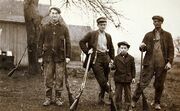The K19 Battle Rifle is the main service rifle of the Armenian Defense Forces and their reservist counterparts. It is a 7.62mm, gas operated, selective fire battle rifle designed to be rugged and durable - as well as able to be mass-produced quickly and efficiently with little technical know-how or tools. Because of Armenia's mountainous terrain, the K19 is designed to shoot accurately over long distances, which is why the decision was made to chamber the rifle in 7.62mm rather than the increasingly-common 5.56mm round. The K19 was designed by a trio of French-Armenians: former employees of GIAT Industries and members of the Armenian Diaspora in France who returned to the country in 1977. The K19 rifle has been used in combat engagements in during the Armenian War in places like Georgia, the Nagorno-Karabakh, and the Erzurum DMZ, and has gradually surpassed other weaponry as the mainstay of Armenian infantry forces. The K19 is capable of mounting the K1 bayonet, a scope for long-range engagements, or the K14 40mm Spigot-type rifle grenade, among various other attachments. An estimated 750,000 have been produced in factories in Poland, Persia, and Armenia.
Design[]

The three inventors of the K19 pose with Fillipe's son in the summer of 1969 in France.
The K19 rifle was designed by Fillipe Azerian, a French-born member of the Armenian Diaspora with an Armenian father and a French mother. The Azerian family emigrated from Armenia in 1893 in the face of increasing hostility from the Turkish government and rising Turko-Russo tensions, and found refuge in Roanne that summer. After mandatory conscription with the French Army in 1959-1963 as a quartermaster, Azerian put his skills to work at French-owned GIAT Industries, finding himself put to work alongside two other Armenian immigrants: Renault Midezian and Albert Yvonien. They worked on upgrading existing weaponry and received technical education in gunsmithing during the 1965-1970 period. But after the Turkish Invasion of Georgia-Armenia in 1970, the three decided that they would start making plans to head back home. They were delayed, but eventually returned after sanctions were lifted in the post-rebellion government. There, they went straight to the newly-formed Armenian Defense Forces to offer their services.
These men analyzed the combat situation in Armenia with the assistance of military advisers, and found that most of the combat occurred at longer ranges. As such, they decided to chamber a rifle in 7.62mm as opposed to the favored European 5.56mm round. Their next step was to create a durable and robust system. For this, they looked to Tsarist and Polish weaponry - some of the most durable in the world. These components were copied into the Armenian rifle, while wooden furniture were added to ease up on resources needed for manufacturing. Indeed, the rifle was also designed in a simple fashion to minimize the difficulty with manufacturers. Anyone could use it, and anyone could build it.